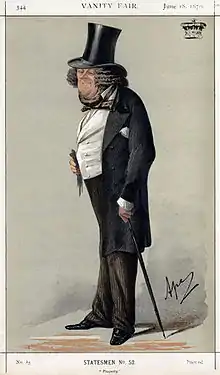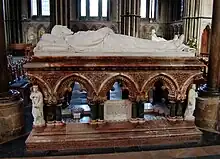William Ward, 1st Earl of Dudley
William Ward, 1st Earl of Dudley (27 March 1817 – 7 May 1885), known as The Lord Ward from 1835 to 1860, was a British landowner and benefactor.
The Earl of Dudley | |
|---|---|
 The Earl of Dudley as caricatured by Ape (Carlo Pellegrini) in Vanity Fair, June 1870 | |
| Personal details | |
| Born | William Ward 27 March 1817 Edwardstone, Boxford, Suffolk |
| Died | 7 May 1885 (aged 68) |
| Spouses | |
| Children | 7, including William Ward, 2nd Earl of Dudley John Hubert Ward |
| Parent(s) | William Ward, 10th Baron Ward Amelia Pillans |
| Education | Eton College |
| Alma mater | Christ Church, Oxford Trinity College, Oxford |
Background and education
Ward was born on 27 March 1817 at Edwardstone, Boxford, Suffolk, England, the son of William Ward, 10th Baron Ward. His mother was Amelia, daughter of William Cooch Pillans.
He was educated at Eton and at Christ Church, Oxford and Trinity College, Oxford.[1] He played first-class cricket for Oxford University Cricket Club between 1838 and 1842.[2]
Career
On 6 December 1835, he inherited the title of Lord Ward, when he became the 11th Baron Ward.[3] His inheritance included Himley Hall and the ruins of Dudley Castle. In 1837 his trustees purchased the Witley Court estate in Worcestershire from Thomas Foley, 4th Baron Foley.
Ward never held any political office,[4] but served as Colonel Commander of the Worcestershire Yeomanry in 1854.[4]
Between 1859 and 1877 Ward paid for the entire refacing and restoration of Worcester Cathedral[5] and there is a monument to him in the cathedral. In 1868 he defrayed one third of the cost of the tower and spire of St John the Baptist's Church at Hagley.[5] He was also a trustee of the National Gallery and the National Portrait Gallery.
In 1860, the earldom held by his kinsman was revived when he was created Viscount Ednam, of Ednam in the County of Roxburgh, and Earl of Dudley, of Dudley Castle in the County of Stafford.[6]
Personal life

Lord Dudley married, firstly, Selina Constance, daughter of Hubert de Burgh, on 24 April 1851. She died on 14 November of the same year, aged only 22. There were no children from this marriage.
He married, secondly, Georgina Elisabeth, daughter of Sir Thomas Moncreiffe, 7th Baronet, and Lady Louisa Hay-Drummond, on 21 November 1865. His sister-in-law Harriet Moncreiffe, who a few years later, as Lady Mordaunt, became embroiled in a sensational divorce case, referred to him as "frizzle wig".[7] Together, William and Georgina were the parents of six sons and one daughter:
- William Humble Ward, 2nd Earl of Dudley (1867–1932), who succeeded his father and became a prominent Conservative politician who married Rachel Gurney CBE, the youngest daughter of Charles Henry Gurney.
- Hon. Sir John Hubert Ward (1870–1938), who married Jean Templeton Reid, daughter of U.S. Ambassador Whitelaw Reid.[8]
- Hon. Robert Arthur Ward (1871–1942), who married Lady Mary Acheson, a daughter of Archibald Acheson, 4th Earl of Gosford and Lady Louisa Montagu (daughter of William Montagu, 7th Duke of Manchester).
- Lady Edith Amelia Ward (1872–1956), who married Frederick Glyn, 4th Baron Wolverton.
- Captain Hon. Reginald Ward, DSO (1874–1904), of the Royal Horse Guards.
- Captain Hon. Cyril Augustus Ward (1876–1930), who married Baroness Irene de Brienen, a daughter of Baron de Brienen. He took part in the Parker expedition to Jerusalem, going to Jerusalem in 1909. He served with the Royal Navy during the First World War. He was declared bankrupt in 1923 and subsequently moved to Kenya where he died.[9][10]
- Hon. Gerald Ernest Francis Ward MVO[11] (1877–1914), a first-class cricketer for Marylebone Cricket Club (MCC),[12] who served in the 1st Life Guards during the First World War and was killed in action[11] at Zandvoorde, Belgium. He married Lady Evelyn Crichton, a daughter of John Crichton, 4th Earl Erne and Lady Florence Cole (daughter of William Cole, 3rd Earl of Enniskillen).
He owned 25,000 acres, with most of his income coming from 5,000 acres in Staffordshire.[13]
Ward died on 7 May 1885, aged 68, at Dudley House, Park Lane, Mayfair, in London, and was originally buried in a marble sarcophagus in the crypt of Saint Michael and All Angels Church in Great Witley, Worcestershire. His remains were later moved to Worcester Cathedral, where a funerary monument to him was erected. The Countess of Dudley survived her husband by over forty years and died in February 1929 at her home at Pembroke Lodge, Richmond Park[14] at the age of 82, having spent over half her life as a widow.
References
- Foster, Joseph (1888–1892). . Alumni Oxonienses: the Members of the University of Oxford, 1715–1886. Oxford: Parker and Co – via Wikisource.
- Cricket Archive: Lord Ward
- Burke, Sir Bernard (1869). A Genealogical and Heraldic Dictionary of the Peerage and Baronetage of the British Empire. London: Harrison and Sons. pp. 367–368.
- Cokayne, George Edward (1910). The Complete Peerage. Vol. 4. London: The St. Catherine Press, Ltd. p. 490.
- Folkes, J. Homery The Victorian Architect and George Edmund Street Transactions of the Worcestershire Archaeological Society. Third Series Vol 4 1974 p9
- "No. 22356". The London Gazette. 14 February 1860. p. 518.
- Hamilton, Elizabeth (1999) The Warwickshire Scandal
- "MISS REID MARRIED AT ST. JAMES'S; To Mr. Ward, the Bridegroom, the King Says, "Well Done, Johnny." QUEEN KISSES THE BRIDE Brilliant Assemblage in the Chapel Royal and at Dorchester House Afterward". The New York Times. 24 June 1908. Retrieved 15 November 2017.
- "£700 lost at Chemin-de-fer". The Manchester Guardian. 28 November 1923.
- Addison, Graham (2021). Raiders of the Hidden Ark: The story of the Parker expedition to Jerusalem. Edgcumbe press. p. 112. ISBN 978-1-9196495-0-4.
- "Ward, the Hon. Gerald Ernest Francis". Commonwealth War Graves Commission. Retrieved 2 June 2014.
- "Gerald Ward". Cricket Archive. Retrieved 2 June 2014.
- The great landowners of Great Britain and Ireland
- "Death of Georgina, Lady Dudley: A Great Lady of the Victorian Age". Glasgow Herald. 9 February 1929.